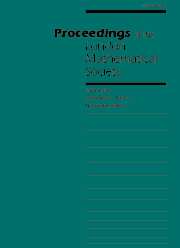Crossref Citations
This article has been cited by the following publications. This list is generated based on data provided by
Crossref.
Calderbank, A.R.
1998.
The art of signaling: fifty years of coding theory.
IEEE Transactions on Information Theory,
Vol. 44,
Issue. 6,
p.
2561.
Calderbank, A.R.
Rains, E.M.
Shor, P.M.
and
Sloane, N.J.A.
1998.
Quantum error correction via codes over GF(4).
IEEE Transactions on Information Theory,
Vol. 44,
Issue. 4,
p.
1369.
Calderbank, A. R.
1999.
Difference Sets, Sequences and their Correlation Properties.
p.
45.
Rains, E.M.
1999.
Nonbinary quantum codes.
IEEE Transactions on Information Theory,
Vol. 45,
Issue. 6,
p.
1827.
Ashikhmin, A.E.
Barg, A.M.
Knill, E.
and
Litsyn, S.N.
2000.
Quantum error detection .I. Statement of the problem.
IEEE Transactions on Information Theory,
Vol. 46,
Issue. 3,
p.
778.
Ericson, Thomas
and
Zinoviev, Victor
2001.
Codes on Euclidean Spheres.
Vol. 63,
Issue. ,
p.
129.
Nebe, G.
Rains, E. M.
and
Sloane, N. J. A.
2002.
Codes, Graphs, and Systems.
Vol. 670,
Issue. ,
p.
333.
Strohmer, T.
Heath, R.W.
and
Paulraj, A.J.
2002.
On the design of optimal spreading sequences for CDMA systems.
Vol. 2,
Issue. ,
p.
1434.
Gribonval, R.
and
Nielsen, M.
2003.
Sparse representations in unions of bases.
IEEE Transactions on Information Theory,
Vol. 49,
Issue. 12,
p.
3320.
Borges, J.
Phelps, K.T.
Rifa, J.
and
Zinoviev, V.A.
2003.
On Z/sub 4/-linear preparata-like and kerdock-like codes.
IEEE Transactions on Information Theory,
Vol. 49,
Issue. 11,
p.
2834.
Strohmer, Thomas
and
Heath, Robert W
2003.
Grassmannian frames with applications to coding and communication.
Applied and Computational Harmonic Analysis,
Vol. 14,
Issue. 3,
p.
257.
Kantor, William M.
2003.
Commutative semifields and symplectic spreads.
Journal of Algebra,
Vol. 270,
Issue. 1,
p.
96.
Gribonval, R.
and
Nielsen, M.
2003.
Sparse decompositions in "incoherent" dictionaries.
Vol. 1,
Issue. ,
p.
I.
Kantor, William
and
Williams, Michael
2003.
Symplectic semifield planes and ℤ₄–linear codes.
Transactions of the American Mathematical Society,
Vol. 356,
Issue. 3,
p.
895.
Heath, R.W.
Tropp, J.A.
Dhillon, I.
and
Strohmer, T.
2004.
Construction of equiangular signatures for synchronous CDMA systems.
p.
708.
Calderbank, A.R.
Diggavi, S.N.
and
Al-Dhahir, N.
2004.
Space-time signaling based on Kerdock and Delsafte-Goethals codes.
p.
483.
Saniga, Metod
Planat, Michel
and
Rosu, Haret
2004.
Mutually unbiased bases and finite projective planes.
Journal of Optics B: Quantum and Semiclassical Optics,
Vol. 6,
Issue. 9,
p.
L19.
Pittenger, Arthur O.
and
Rubin, Morton H.
2004.
Mutually unbiased bases, generalized spin matrices and separability.
Linear Algebra and its Applications,
Vol. 390,
Issue. ,
p.
255.
Gibbons, Kathleen S.
Hoffman, Matthew J.
and
Wootters, William K.
2004.
Discrete phase space based on finite fields.
Physical Review A,
Vol. 70,
Issue. 6,
Solov'eva, F. I.
2005.
On the Construction of Transitive Codes.
Problems of Information Transmission,
Vol. 41,
Issue. 3,
p.
204.


